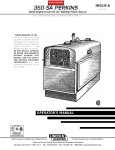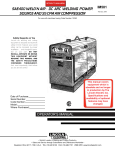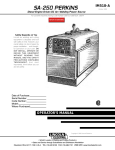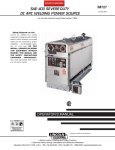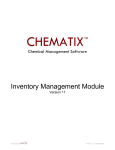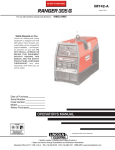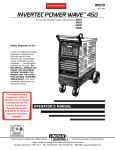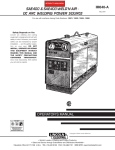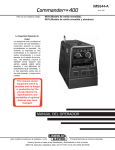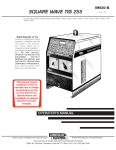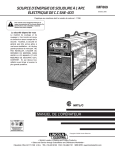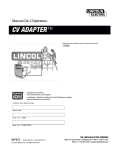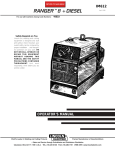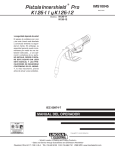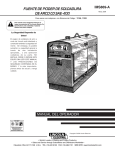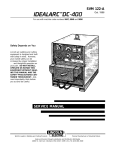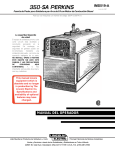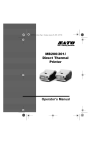Download Lincoln Electric SAM650 User's Manual
Transcript
RETURN TO MAIN MENU IM568 SAM400 & 650 PERKINS DIESEL ENGINE DRIVEN MULTI-PROCESS DC ARC WELDING POWER SOURCES April, 1997 For use with SAM400 machines having Code Numbers: 10140 & 10141 For use with SAM650 machines having Code Number: 10333 Supersedes IM247-D Safety Depends on You Lincoln arc welding and cutting equipment is designed and built with safety in mind. However, your overall safety can be increased by proper installation ... and thoughtful operation on your part. DO NOT INSTALL, OPERATE OR REPAIR THIS EQUIPMENT WITHOUT READING THIS MANUAL AND THE SAFETY PRECAUTIONS CONTAINED THROUGHOUT. And, most importantly, think before you act and be careful. OPERATOR’S MANUAL World's Leader in Welding and Cutting Products Premier Manufacturer of Industrial Motors Sales and Service through Subsidiaries and Distributors Worldwide 22801 St. Clair Ave. Cleveland, Ohio 44117-1199 U.S.A. Tel. (216) 481-8100 i i SAFETY WARNING CALIFORNIA PROPOSITION 65 WARNINGS Diesel engine exhaust and some of its constituents are known to the State of California to cause cancer, birth defects, and other reproductive harm. The Above For Diesel Engines The engine exhaust from this product contains chemicals known to the State of California to cause cancer, birth defects, or other reproductive harm. The Above For Gasoline Engines ARC WELDING CAN BE HAZARDOUS. PROTECT YOURSELF AND OTHERS FROM POSSIBLE SERIOUS INJURY OR DEATH. KEEP CHILDREN AWAY. PACEMAKER WEARERS SHOULD CONSULT WITH THEIR DOCTOR BEFORE OPERATING. Read and understand the following safety highlights. For additional safety information, it is strongly recommended that you purchase a copy of “Safety in Welding & Cutting - ANSI Standard Z49.1” from the American Welding Society, P.O. Box 351040, Miami, Florida 33135 or CSA Standard W117.2-1974. A Free copy of “Arc Welding Safety” booklet E205 is available from the Lincoln Electric Company, 22801 St. Clair Avenue, Cleveland, Ohio 44117-1199. BE SURE THAT ALL INSTALLATION, OPERATION, MAINTENANCE AND REPAIR PROCEDURES ARE PERFORMED ONLY BY QUALIFIED INDIVIDUALS. FOR ENGINE powered equipment. 1.h. To avoid scalding, do not remove the radiator pressure cap when the engine is hot. 1.a. Turn the engine off before troubleshooting and maintenance work unless the maintenance work requires it to be running. ____________________________________________________ 1.b. Operate engines in open, well-ventilated areas or vent the engine exhaust fumes outdoors. ____________________________________________________ 1.c. Do not add the fuel near an open flame welding arc or when the engine is running. Stop the engine and allow it to cool before refueling to prevent spilled fuel from vaporizing on contact with hot engine parts and igniting. Do not spill fuel when filling tank. If fuel is spilled, wipe it up and do not start engine until fumes have been eliminated. ____________________________________________________ 1.d. Keep all equipment safety guards, covers and devices in position and in good repair.Keep hands, hair, clothing and tools away from Vbelts, gears, fans and all other moving parts when starting, operating or repairing equipment. ____________________________________________________ 1.e. In some cases it may be necessary to remove safety guards to perform required maintenance. Remove guards only when necessary and replace them when the maintenance requiring their removal is complete. Always use the greatest care when working near moving parts. ___________________________________________________ 1.f. Do not put your hands near the engine fan. Do not attempt to override the governor or idler by pushing on the throttle control rods while the engine is running. ___________________________________________________ 1.g. To prevent accidentally starting gasoline engines while turning the engine or welding generator during maintenance work, disconnect the spark plug wires, distributor cap or magneto wire as appropriate. ELECTRIC AND MAGNETIC FIELDS may be dangerous 2.a. Electric current flowing through any conductor causes localized Electric and Magnetic Fields (EMF). Welding current creates EMF fields around welding cables and welding machines 2.b. EMF fields may interfere with some pacemakers, and welders having a pacemaker should consult their physician before welding. 2.c. Exposure to EMF fields in welding may have other health effects which are now not known. 2.d. All welders should use the following procedures in order to minimize exposure to EMF fields from the welding circuit: 2.d.1. Route the electrode and work cables together - Secure them with tape when possible. 2.d.2. Never coil the electrode lead around your body. 2.d.3. Do not place your body between the electrode and work cables. If the electrode cable is on your right side, the work cable should also be on your right side. 2.d.4. Connect the work cable to the workpiece as close as possible to the area being welded. 2.d.5. Do not work next to welding power source. Mar ‘95 SAM400 & 650 ii ii SAFETY ELECTRIC SHOCK can kill. ARC RAYS can burn. 3.a. The electrode and work (or ground) circuits are electrically “hot” when the welder is on. Do not touch these “hot” parts with your bare skin or wet clothing. Wear dry, hole-free gloves to insulate hands. 4.a. Use a shield with the proper filter and cover plates to protect your eyes from sparks and the rays of the arc when welding or observing open arc welding. Headshield and filter lens should conform to ANSI Z87. I standards. 3.b. Insulate yourself from work and ground using dry insulation. Make certain the insulation is large enough to cover your full area of physical contact with work and ground. 4.b. Use suitable clothing made from durable flame-resistant material to protect your skin and that of your helpers from the arc rays. In addition to the normal safety precautions, if welding must be performed under electrically hazardous conditions (in damp locations or while wearing wet clothing; on metal structures such as floors, gratings or scaffolds; when in cramped positions such as sitting, kneeling or lying, if there is a high risk of unavoidable or accidental contact with the workpiece or ground) use the following equipment: • Semiautomatic DC Constant Voltage (Wire) Welder. • DC Manual (Stick) Welder. • AC Welder with Reduced Voltage Control. 4.c. Protect other nearby personnel with suitable, non-flammable screening and/or warn them not to watch the arc nor expose themselves to the arc rays or to hot spatter or metal. 3.c. In semiautomatic or automatic wire welding, the electrode, electrode reel, welding head, nozzle or semiautomatic welding gun are also electrically “hot”. 3.d. Always be sure the work cable makes a good electrical connection with the metal being welded. The connection should be as close as possible to the area being welded. 3.e. Ground the work or metal to be welded to a good electrical (earth) ground. 3.f. Maintain the electrode holder, work clamp, welding cable and welding machine in good, safe operating condition. Replace damaged insulation. 3.g. Never dip the electrode in water for cooling. 3.h. Never simultaneously touch electrically “hot” parts of electrode holders connected to two welders because voltage between the two can be the total of the open circuit voltage of both welders. 3.i. When working above floor level, use a safety belt to protect yourself from a fall should you get a shock. 3.j. Also see Items 6.c. and 8. FUMES AND GASES can be dangerous. 5.a. Welding may produce fumes and gases hazardous to health. Avoid breathing these fumes and gases.When welding, keep your head out of the fume. Use enough ventilation and/or exhaust at the arc to keep fumes and gases away from the breathing zone. When welding with electrodes which require special ventilation such as stainless or hard facing (see instructions on container or MSDS) or on lead or cadmium plated steel and other metals or coatings which produce highly toxic fumes, keep exposure as low as possible and below Threshold Limit Values (TLV) using local exhaust or mechanical ventilation. In confined spaces or in some circumstances, outdoors, a respirator may be required. Additional precautions are also required when welding on galvanized steel. 5.b. Do not weld in locations near chlorinated hydrocarbon vapors coming from degreasing, cleaning or spraying operations. The heat and rays of the arc can react with solvent vapors to form phosgene, a highly toxic gas, and other irritating products. 5.c. Shielding gases used for arc welding can displace air and cause injury or death. Always use enough ventilation, especially in confined areas, to insure breathing air is safe. 5.d. Read and understand the manufacturer’s instructions for this equipment and the consumables to be used, including the material safety data sheet (MSDS) and follow your employer’s safety practices. MSDS forms are available from your welding distributor or from the manufacturer. 5.e. Also see item 1.b. SAM400 & 650 Mar ‘95 iii iii SAFETY WELDING SPARKS can cause fire or explosion. 6.a. Remove fire hazards from the welding area. If this is not possible, cover them to prevent the welding sparks from starting a fire. Remember that welding sparks and hot materials from welding can easily go through small cracks and openings to adjacent areas. Avoid welding near hydraulic lines. Have a fire extinguisher readily available. 6.b. Where compressed gases are to be used at the job site, special precautions should be used to prevent hazardous situations. Refer to “Safety in Welding and Cutting” (ANSI Standard Z49.1) and the operating information for the equipment being used. 6.c. When not welding, make certain no part of the electrode circuit is touching the work or ground. Accidental contact can cause overheating and create a fire hazard. 6.d. Do not heat, cut or weld tanks, drums or containers until the proper steps have been taken to insure that such procedures will not cause flammable or toxic vapors from substances inside. They can cause an explosion even though they have been “cleaned”. For information, purchase “Recommended Safe Practices for the Preparation for Welding and Cutting of Containers and Piping That Have Held Hazardous Substances”, AWS F4.1 from the American Welding Society (see address above). 6.e. Vent hollow castings or containers before heating, cutting or welding. They may explode. 6.f. Sparks and spatter are thrown from the welding arc. Wear oil free protective garments such as leather gloves, heavy shirt, cuffless trousers, high shoes and a cap over your hair. Wear ear plugs when welding out of position or in confined places. Always wear safety glasses with side shields when in a welding area. 6.g. Connect the work cable to the work as close to the welding area as practical. Work cables connected to the building framework or other locations away from the welding area increase the possibility of the welding current passing through lifting chains, crane cables or other alternate circuits. This can create fire hazards or overheat lifting chains or cables until they fail. 6.h. Also see item 1.c. CYLINDER may explode if damaged. 7.a. Use only compressed gas cylinders containing the correct shielding gas for the process used and properly operating regulators designed for the gas and pressure used. All hoses, fittings, etc. should be suitable for the application and maintained in good condition. 7.b. Always keep cylinders in an upright position securely chained to an undercarriage or fixed support. 7.c. Cylinders should be located: • Away from areas where they may be struck or subjected to physical damage. • A safe distance from arc welding or cutting operations and any other source of heat, sparks, or flame. 7.d. Never allow the electrode, electrode holder or any other electrically “hot” parts to touch a cylinder. 7.e. Keep your head and face away from the cylinder valve outlet when opening the cylinder valve. 7.f. Valve protection caps should always be in place and hand tight except when the cylinder is in use or connected for use. 7.g. Read and follow the instructions on compressed gas cylinders, associated equipment, and CGA publication P-l, “Precautions for Safe Handling of Compressed Gases in Cylinders,” available from the Compressed Gas Association 1235 Jefferson Davis Highway, Arlington, VA 22202. FOR ELECTRICALLY powered equipment. 8.a. Turn off input power using the disconnect switch at the fuse box before working on the equipment. 8.b. Install equipment in accordance with the U.S. National Electrical Code, all local codes and the manufacturer’s recommendations. 8.c. Ground the equipment in accordance with the U.S. National Electrical Code and the manufacturer’s recommendations. Mar ‘95 SAM400 & 650 iv iv SAFETY PRÉCAUTIONS DE SÛRETÉ Pour votre propre protection lire et observer toutes les instructions et les précautions de sûreté specifiques qui parraissent dans ce manuel aussi bien que les précautions de sûreté générales suivantes: Sûreté Pour Soudage A L’Arc 1. Protegez-vous contre la secousse électrique: a. Les circuits à l’électrode et à la piéce sont sous tension quand la machine à souder est en marche. Eviter toujours tout contact entre les parties sous tension et la peau nue ou les vétements mouillés. Porter des gants secs et sans trous pour isoler les mains. b. Faire trés attention de bien s’isoler de la masse quand on soude dans des endroits humides, ou sur un plancher metallique ou des grilles metalliques, principalement dans les positions assis ou couché pour lesquelles une grande partie du corps peut être en contact avec la masse. c. Maintenir le porte-électrode, la pince de masse, le câble de soudage et la machine à souder en bon et sûr état defonctionnement. d.Ne jamais plonger le porte-électrode dans l’eau pour le refroidir. e. Ne jamais toucher simultanément les parties sous tension des porte-électrodes connectés à deux machines à souder parce que la tension entre les deux pinces peut être le total de la tension à vide des deux machines. f. Si on utilise la machine à souder comme une source de courant pour soudage semi-automatique, ces precautions pour le porte-électrode s’applicuent aussi au pistolet de soudage. 2. Dans le cas de travail au dessus du niveau du sol, se protéger contre les chutes dans le cas ou on recoit un choc. Ne jamais enrouler le câble-électrode autour de n’importe quelle partie du corps. 3. Un coup d’arc peut être plus sévère qu’un coup de soliel, donc: a. Utiliser un bon masque avec un verre filtrant approprié ainsi qu’un verre blanc afin de se protéger les yeux du rayonnement de l’arc et des projections quand on soude ou quand on regarde l’arc. b. Porter des vêtements convenables afin de protéger la peau de soudeur et des aides contre le rayonnement de l‘arc. c. Protéger l’autre personnel travaillant à proximité au soudage à l’aide d’écrans appropriés et non-inflammables. 4. Des gouttes de laitier en fusion sont émises de l’arc de soudage. Se protéger avec des vêtements de protection libres de l’huile, tels que les gants en cuir, chemise épaisse, pantalons sans revers, et chaussures montantes. 6. Eloigner les matériaux inflammables ou les recouvrir afin de prévenir tout risque d’incendie dû aux étincelles. 7. Quand on ne soude pas, poser la pince à une endroit isolé de la masse. Un court-circuit accidental peut provoquer un échauffement et un risque d’incendie. 8. S’assurer que la masse est connectée le plus prés possible de la zone de travail qu’il est pratique de le faire. Si on place la masse sur la charpente de la construction ou d’autres endroits éloignés de la zone de travail, on augmente le risque de voir passer le courant de soudage par les chaines de levage, câbles de grue, ou autres circuits. Cela peut provoquer des risques d’incendie ou d’echauffement des chaines et des câbles jusqu’à ce qu’ils se rompent. 9. Assurer une ventilation suffisante dans la zone de soudage. Ceci est particuliérement important pour le soudage de tôles galvanisées plombées, ou cadmiées ou tout autre métal qui produit des fumeés toxiques. 10. Ne pas souder en présence de vapeurs de chlore provenant d’opérations de dégraissage, nettoyage ou pistolage. La chaleur ou les rayons de l’arc peuvent réagir avec les vapeurs du solvant pour produire du phosgéne (gas fortement toxique) ou autres produits irritants. 11. Pour obtenir de plus amples renseignements sur la sûreté, voir le code “Code for safety in welding and cutting” CSA Standard W 117.2-1974. PRÉCAUTIONS DE SÛRETÉ POUR LES MACHINES À SOUDER À TRANSFORMATEUR ET À REDRESSEUR 1. Relier à la terre le chassis du poste conformement au code de l’électricité et aux recommendations du fabricant. Le dispositif de montage ou la piece à souder doit être branché à une bonne mise à la terre. 2. Autant que possible, I’installation et l’entretien du poste seront effectués par un électricien qualifié. 3. Avant de faires des travaux à l’interieur de poste, la debrancher à l’interrupteur à la boite de fusibles. 4. Garder tous les couvercles et dispositifs de sûreté à leur place. 5. Toujours porter des lunettes de sécurité dans la zone de soudage. Utiliser des lunettes avec écrans lateraux dans les zones où l’on pique le laitier. SAM400 & 650 Mar. ‘93 v v Thank You for selecting a QUALITY product by Lincoln Electric. We want you to take pride in operating this Lincoln Electric Company product ••• as much pride as we have in bringing this product to you! Please Examine Carton and Equipment For Damage Immediately When this equipment is shipped, title passes to the purchaser upon receipt by the carrier. Consequently, Claims for material damaged in shipment must be made by the purchaser against the transportation company at the time the shipment is received. Please record your equipment identification information below for future reference. This information can be found on your machine nameplate. Model Name & Number _____________________________________ Code & Serial Number _____________________________________ Date of Purchase _____________________________________ Whenever you request replacement parts for or information on this equipment always supply the information you have recorded above. Read this Operators Manual completely before attempting to use this equipment. Save this manual and keep it handy for quick reference. Pay particular attention to the safety instructions we have provided for your protection. The level of seriousness to be applied to each is explained below: WARNING This statement appears where the information must be followed exactly to avoid serious personal injury or loss of life. CAUTION This statement appears where the information must be followed to avoid minor personal injury or damage to this equipment. SAM400 & 650 vi vi TABLE OF CONTENTS Page Installation Instructions . . . . . . . . . . . . . . . . . . . . . . . . . . . . . . . . . . . . . . . . . . . . Section A Technical Specifications . . . . . . . . . . . . . . . . . . . . . . . . . . . . . . . . . . . . . . . . . . . . . . . .A-1 Product Description . . . . . . . . . . . . . . . . . . . . . . . . . . . . . . . . . . . . . . . . . . . . . . . . . . A-3 Installation Precautions . . . . . . . . . . . . . . . . . . . . . . . . . . . . . . . . . . . . . . . . . . . . . . . . A-3 Spark Arrester . . . . . . . . . . . . . . . . . . . . . . . . . . . . . . . . . . . . . . . . . . . . . . . . . . . A-3 Machine Grounding . . . . . . . . . . . . . . . . . . . . . . . . . . . . . . . . . . . . . . . . . . . . . . . A-3 Additional Safety Precautions . . . . . . . . . . . . . . . . . . . . . . . . . . . . . . . . . . . . . . . . A-3 Pre-Operation Service . . . . . . . . . . . . . . . . . . . . . . . . . . . . . . . . . . . . . . . . . . . . . . . . A-4 Output Cables . . . . . . . . . . . . . . . . . . . . . . . . . . . . . . . . . . . . . . . . . . . . . . . . . . . . . . A-4 Welder Location . . . . . . . . . . . . . . . . . . . . . . . . . . . . . . . . . . . . . . . . . . . . . . . . . . . . . A-4 Operating Instructions . . . . . . . . . . . . . . . . . . . . . . . . . . . . . . . . . . . . . . . . . . . . . Section B Operating Precautions . . . . . . . . . . . . . . . . . . . . . . . . . . . . . . . . . . . . . . . . . . . . . . . . B-1 Pipe Thawing . . . . . . . . . . . . . . . . . . . . . . . . . . . . . . . . . . . . . . . . . . . . . . . . . . . . . . . B-1 Additional Safety Precautions . . . . . . . . . . . . . . . . . . . . . . . . . . . . . . . . . . . . . . . . . . . B-1 Engine Controls: Function/Operation . . . . . . . . . . . . . . . . . . . . . . . . . . . . . . . . . . . . . . B-1 Welder Controls: Function/Operation . . . . . . . . . . . . . . . . . . . . . . . . . . . . . . . . . . . . . . B-2 Starting Welders with Dead Batteries . . . . . . . . . . . . . . . . . . . . . . . . . . . . . . . . . . . . . .B-9 Auxiliary Power . . . . . . . . . . . . . . . . . . . . . . . . . . . . . . . . . . . . . . . . . . . . . . . . . . . . . . B-9 Duty Cycle . . . . . . . . . . . . . . . . . . . . . . . . . . . . . . . . . . . . . . . . . . . . . . . . . . . . . . . . . B-9 Starting Instructions . . . . . . . . . . . . . . . . . . . . . . . . . . . . . . . . . . . . . . . . . . . . . . . . . . B-9 Break-In Period . . . . . . . . . . . . . . . . . . . . . . . . . . . . . . . . . . . . . . . . . . . . . . . . . . . . . B-9 Accessories . . . . . . . . . . . . . . . . . . . . . . . . . . . . . . . . . . . . . . . . . . . . . . . . . . . . . .Section C Maintenance . . . . . . . . . . . . . . . . . . . . . . . . . . . . . . . . . . . . . . . . . . . . . . . . . . . . . Section D Routine Maintenance . . . . . . . . . . . . . . . . . . . . . . . . . . . . . . . . . . . . . . . . . . . . . . . . . D-1 Periodic Maintenance . . . . . . . . . . . . . . . . . . . . . . . . . . . . . . . . . . . . . . . . . . . . . . . . . D-1 Troubleshooting Guide . . . . . . . . . . . . . . . . . . . . . . . . . . . . . . . . . . . . . . . . . . . . . Section E Diode Test Procedure . . . . . . . . . . . . . . . . . . . . . . . . . . . . . . . . . . . . . . . . . . . . . . . . .E-6 SCR Bridge PC Board Test Procedure . . . . . . . . . . . . . . . . . . . . . . . . . . . . . . . . . . . . .E-6 Control PC Board Calibration . . . . . . . . . . . . . . . . . . . . . . . . . . . . . . . . . . . . . . . . . . . .E-7 Ground Tests . . . . . . . . . . . . . . . . . . . . . . . . . . . . . . . . . . . . . . . . . . . . . . . . . . . . . . . .E-8 Wiring Diagrams and Dimension Print . . . . . . . . . . . . . . . . . . . . . . . . . . . . . . . . . Section F Parts List . . . . . . . . . . . . . . . . . . . . . . . . . . . . . . . . . . . . . . . . . . . . . . . . . . . . . . . .Appendix SAM400 & 650 A-1 A-1 INSTALLATION TECHNICAL SPECIFICATIONS - SAM400 INPUT - DIESEL ENGINE Make/Model Description Speed (RPM) Displacement Starting System Capacities Perkins 4.236 Diesel Engine 4 cylinder 63 HP @ 1725 RPM High Idle 1790 Low Idle 1100 Full Load 1725 236 cu. in (3.87 L) 12VDC batteries (2) & Starter Fuel: 22.5 gal. 85.1 L Bore x Stroke Oil: 8.5 Qts. 8.04 L 3.875” x 5.00” (98.4 mm x 127.0mm) Coolant: 3.2 gal. 12.11 L RATED OUTPUT - WELDER Duty Cycle Welding Output Volts at Rated Amps 60% (NEMA) 400 amps 36 volts 60% (Lincoln Plus) 400 amps 40 volts OUTPUT - WELDER AND GENERATOR Welding Range Open Circuit Voltage Auxiliary Power 60 - 500 Amps CV Current Range 80 - 500 VV Current Range 17 - 45 OCV 120/240 VAC 2kVA, 60 Hz. 100% Duty Cycle (excluding hot start voltage) 60 - 95 OCV PHYSICAL DIMENSIONS HEIGHT1 WIDTH DEPTH WEIGHT 50.13 in. 27.12 in. 83.00 in. 2163 lbs. 1273.3 mm 688.9 mm 2108.2 mm 981.1 kg 1. Add 15.4” (391.2 mm) for optional muffler. SAM400 & 650 A-2 A-2 INSTALLATION TECHNICAL SPECIFICATIONS - SAM650 INPUT - DIESEL ENGINE Make/Model Description Speed (RPM) Displacement Starting System Capacities Perkins 1006-6 Diesel Engine 6 cylinder 93 HP @ 1730 RPM High Idle 1790 Low Idle 1200 Full Load 1750 365 cu. in (5.98 L) 12VDC batteries (2) & Starter Fuel: 22.5 gal. 85.1 L Bore x Stroke Oil: 14.0 Qts. 13.24 L 3.937” x 5.00” (100mm x 127mm) Coolant: 5.5 gal. 20.8 L RATED OUTPUT - WELDER Duty Cycle 80% (NEMA) 60%(NEMA) 80%(Lincoln Plus) 60%(Lincoln Plus) Welding Output 650 Amps 725 Amps 650 Amps 725 Amps Volts at Rated Amps 44 volts 44 volts 50 volts 50 volts OUTPUT - WELDER AND GENERATOR Welding Range Open Circuit Voltage Auxiliary Power 80 - 815 Amps CV Current Range 80 - 815 VV Current Range 18 - 50 OCV 120/240 VAC 2kVA, 60 Hz. 100% Duty Cycle (excluding hot start voltage) 45 - 90 OCV PHYSICAL DIMENSIONS HEIGHT WIDTH DEPTH WEIGHT 56.7 in. 27.12 in. 88.75 in. 2800 lbs. 1440.2 mm 688.9 mm 2254.2 mm 1270.1 kg SAM400 & 650 A-3 A-3 INSTALLATION PRODUCT DESCRIPTION The SAM engine welders are multi-purpose welding machines. They are designed to be used on all open arc or submerged arc processes within the rating of the unit. earth ground such as a metal water pipe going into the ground for at least ten feet and having no insulated joints, or to the metal framework of a building which has been effectively grounded. The National Electrical Code lists a number of alternate means of grounding electrical equipment. The machine is designed to be used with the following automatic equipment: LN-7, LN-8, LN-9, LN-22, LN23P (with Adapter Kit), LN-25, NA-3, LT-7, or LT-56. It can be used with most other equipment whose power requirements do not exceed the rating of the machine. WARNING The SAM machines have two types of output characteristics; a variable voltage output characteristic for stick and submerged arc welding and also constant voltage characteristics for Innershield® plus both diptransfer and spray-transfer processes. ● INSTALLATION PRECAUTIONS ● ADDITIONAL SAFETY PRECAUTIONS FALLING EQUIPMENT can cause injury. ● Do not lift this machine using lift bale if it is equipped with a heavy accessory such as trailer or gas cylinder. Lift only with equipment of adequate lifting capacity. Be sure machine is stable when lifting. SPARK ARRESTER Some federal, state or local laws may require that diesel engines be equipped with exhaust spark arresters when they are operated in certain locations where unarrested sparks may present a fire hazard. The standard mufflers included with these welders do not qualify as spark arresters. When required by local regulations suitable spark arresters must be installed and properly maintained. CAUTION An incorrect arrester may lead to damage of the engine or its performance. Contact the engine manufacturer for specific recommendations. MACHINE GROUNDING The 1984 National Electrical Code does not require this machine to be grounded under normal operating circumstances. Some state, local or other codes or unusual operating circumstances may require the machine frame to be grounded. It is recommended that you determine the extent to which such requirements may apply to your particular situation and follow them explicitly. A machine grounding stud marked with the symbol is provided on the welding generator frame foot. The recommended undercarriage for use with this equipment for in-plant and yard towing by a vehicle is Lincoln’s K767-1. If the user adapts a non-Lincoln undercarriage, he must assume responsibility that the method of attachment and usage does not result in a safety hazard nor damage the welding equipment. Some of the factors to be considered are as follows: 1. Design capacity of undercarriage vs. weight of Lincoln equipment and likely additional attachments. 2. Proper support of, and attachment to, the base of the welding equipment so there will be no undue stress to the framework. 3. Proper placement of the equipment on the undercarriage to insure stability side to side and front to back when being moved and when standing by itself while being operated or serviced. 4. Typical conditions of use, i.e., travel speed; roughness of surface on which the undercarriage will be operated; environmental conditions; likely maintenance. 5. Conformance with federal, state and local laws.(1) (1) In general, if the machine is to be grounded it should be connected with a #8 or larger copper wire to a solid Consult applicable federal, state and local laws regarding specific requirements for use on public highways. SAM400 & 650 A-4 PRE-OPERATION SERVICE IMPORTANT: To prevent ELECTRICAL DAMAGE WHEN: Oil: This unit is supplied from the factory with the engine crankcase filled with a high quality 10W30 oil. This oil should be acceptable for most typical ambient temperatures. Consult the Engine Operation Manual for specific recommendations. Upon receipt of the welder, check the dipstick to be sure the oil is at the "full" mark. DO NOT OVERFILL. Fuel: Fill the fuel tank with the grade of diesel fuel recommended in the engine Instruction Manual. Open the fuel feed valve on the sediment bowl by turning the handle counterclockwise. Cooling System:The cooling system has been filled at the factory with a 50-50 mixture of ethylene glycol antifreeze and water. Check the radiator level and add a 50-50 solution as needed. (See Engine Manual or antifreeze container for alternate antifreeze recommendation.) Battery: Remove the insulating cap from the negative battery terminal. Replace and tighten negative battery cable terminal. NOTE: This machine is furnished with wet charged batteries; if unused for several months, the batteries may require a booster charge. Be sure to use the correct polarity when charging the batteries. WARNING GASES FROM BATTERY can explode. ● Keep sparks, flame and cigarettes away from battery. To prevent EXPLOSION when: ● INSTALLING A NEW BATTERY — disconnect negative cable from old battery first and connect to new battery last. ● CONNECTING A BATTERY CHARGER — remove battery from welder by disconnecting negative cable first, then positive cable and battery clamp. When reinstalling, connect negative cable last. Keep well ventilated. ● ● A-4 INSTALLATION USING A BOOSTER — connect positive lead to battery first then connect negative lead to negative battery lead at engine foot. BATTERY ACID can burn eyes and skin. ● Wear gloves and eye protection and be careful when working near battery. Follow instructions printed on battery. a) Installing new batteries. b) Using a booster. Use correct polarity — Negative Ground. To prevent BATTERY BUCKLING, tighten nuts on batteries only until snug. DO NOT OVERTIGHTEN. Muffler: On SAM650 units: Screw the muffler into the exhaust flange and tighten. On SAM400 units with the optional noise control muffler: Attach the muffler with the supplied hardware. The engine and welder controls were properly set at the factory and should require no adjusting when received. OUTPUT CABLES With the engine off, connect the electrode and work cables to the studs provided. These connections should be checked periodically and tightened if necessary. When welding at a considerable distance from the welder, be sure you use ample size welding cables. Listed below are copper cable sizes recommended for the rated current and duty cycle. Lengths stipulated are the distance from the welder to work and back to the welder again. Cable sizes are increased for greater lengths primarily for the purpose of minimizing cable voltage drop. Amps % Duty Cycle 650 650 400 60 80 60 Cable Sizes For Combined Lengths Of Electrode And Work Cables 0-100 ft. 100-200 ft. 200-250 ft. 3/0 2-1/0 2/0 2-2/0 2-2/0 3/0 2-3/0 2-3/0 4/0 WELDER LOCATION The welder should be located to provide an unrestricted flow of clean, cool air to the cooling air inlets (louvered panel and below side doors) and to avoid heated air coming out the radiator of the welder recirculating back to the cooling air inlets. Also, locate the welder so that engine fumes are properly exhausted. SAM400 & 650 B-1 OPERATION OPERATING PRECAUTIONS B-1 SPEED CONTROL LEVER WARNING Do not attempt to use this equipment until you have thoroughly read the engine manufacturer’s manual supplied with your welder. It includes important safety precautions, detailed engine starting, operating and maintenance instructions, and parts lists. Manually allows the engine to run at its high idle speed controlled by the governor or at the factory set low idle speed. When welding or using auxiliary power the speed control lever must be in the “RUN” position. To reduce the engine to low idle speed when not welding or not using auxiliary power place the speed control lever in the “IDLE” position notch. ENGINE TEMPERATURE GAUGE PIPE THAWING Displays the coolant temperature in the engine block. WARNING OIL PRESSURE GAUGE PIPE THAWING can result in fire or explosion. ● Only connect welder across FROZEN section of CONTINUOUS METAL PIPE. ● While thawing, remove any ground leads nected to Frozen pipe. ● Turn welder on AFTER cables are connected to pipe. Turn off when done. Displays the oil pressure to the engine. When the engine starts running, watch for the oil pressure to build up. If no pressure shows within 30 seconds, stop the engine and consult the engine instruction manual. conBATTERY CHARGING AMMETER IMPORTANT: DO NOT USE A WELDER TO THAW A PIPE BEFORE REVIEWING LINCOLN BULLETIN E695.1 (dated May 1987 or later). This bulletin may be obtained from your local Lincoln distributor or by writing directly to Lincoln Electric at the address on the back of this manual. Displays the current going from the charging alternator into the batteries. It is normal for charging current to be high (above 15 amps) after starting or when the batteries are ‘low’ on charge. ENGINE HOUR METER (Factory Installed Optional Feature) The optional engine hour meter records the total running time on the engine in hours. It can be used to keep a record of maintenance on the engine and or welder. ADDITIONAL SAFETY PRECAUTIONS Always operate the welder with the hinged doors closed as these provide maximum protection from moving parts and insure proper cooling air flow. Read carefully the Safety Precautions page in the Instruction Manual before operating this machine. Always follow these and any other safety procedures included in this manual and in the engine instruction manual. ENGINE PROTECTION SYSTEM The engine protection system shuts down the engine under high coolant temperature or low oil pressure conditions by allowing the fuel solenoid valve to close. ENGINE CONTROLS: FUNCTION/OPERATION IGNITION SWITCH When placed in the “ON” position, this switch energizes the fuel solenoid. When placed in the “OFF” position, the flow of fuel to the injection pump is stopped to shut down the engine. SAM400 & 650 B-2 B-2 OPERATION WELDER CONTROLS: FUNCTION/OPERATION place. PORTABLE FIELD CONTROL CONNECTION 3. Remove the two screws on the top end of the wire feeder nameplate. A “Portable Field Control” complete with 25’ leads is shipped with each SAM welder. 4. Position the “Portable Field Control” mounting slots over these holes and replace the screws. A “Portable Field Control” is not required for proper operation of the SAM welder when connected to an LN-8, LN-9, NA-3, NA-5, LT-7, or LT-56 wire feeder. With other wire feeders and when stick electrode welding, the “Portable Field Control” must be installed or the SAM cannot produce its full open circuit voltage. 5. Route the leads with the LN-5 or LN-6 control cable back to the power source. When installed the “Portable Field Control” is a fine voltage adjustment when using the SAM as a constant voltage power source. It is a fine current adjustment when using the SAM as a variable voltage power source. The “Portable Field Control” can be mounted on the SAM or wherever convenient for the welding operation. When using an LN-4, LN-5, LN-6 or LN-7 wire feeder, the control should normally be mounted on the wire feeder. Specific mounting instructions are given below. After mounting, connect the “Portable Field Control” leads to #75 and #76 on the SAM terminal strip located behind the lower cover panel directly below the control panel on the SAM400 or behind the right front hinged door on the SAM650. Connect the green lead of the “Portable Field Control” to the grounding stud marked with the symbol located near the terminal strips. MOUNTING ON LN-4 (Discontinued) 1. Place the “Portable Field Control” on the vertical front panel of the LN-4 on the wire reel side (next to the rheostat panel) and mark the location of the mounting slots. 2. Drill two holes in the panel and mount the control using #10 sheet metal screws. 3. Route the leads with the LN-4 control cable back to the power source. MOUNTING ON LN-7 1. Remove the top screws on the side of the LN-7 control box cover. (This is the left side when facing the nameplate). 2. Position the “Portable Field Control” on the side of the control box with the mounting slots over these holes and replace the screws. 3. Route the leads with the LN-7 control cable back to the power source. OUTPUT STUDS With the Engine OFF connect the work cable to the “To Work” stud. A. For Stick Electrode Welding 1. Connect the electrode cable to the “Stick” stud and the work cable to the “To Work” stud. Connect the “TAP” lead in the SAM650 to the appropriate stud to adjust current and the arc characteristics as described under “Current and Voltage Controls.” 2. Install the “Portable Field Control”. B. Automatic or Semiautomatic Welding For all automatic welding processes, connect the welding power cable from the wire feeder to the “Connect to Auto. Equipment” stud. Connect the “TAP” lead in the SAM650 to the appropriate stud to adjust current and the arc characteristics as described under “Current and Voltage Controls.” 1. LN-7, LN-8, LN-9, NA-3, NA-5, LT-7 and LT56 Wire Feeders. MOUNTING ON LN-5 OR LN-6 (Discontinued) 1. Remove the knob from the upper rheostat on the wire feeder control panel. 2. Be sure the appropriate wire feeder nameplate “Constant Voltage” or “ Variable Voltage “ - is in SAM400 & 650 a. Make the connections exactly as specified on the connection wiring diagram included in the wire feeder Instruction Manual. b. Install the “Portable Field Control” when using an LN-7. B-3 OPERATION c. Be sure the wire feeder is properly set for constant or variable voltage as appropriate. 2. ML-2, ML-3, MN-1, LN-4, LN-5 and LN-6 Wire Feeders This power source can be used with these obsolete wire feeders. Write to the factory for specific connections. 3. Other Wire Feeders This power source can be used with wire feeders manufactured by other companies. The connection must be determined by the customer for the specific equipment being used. Auxiliary power available for wire feeder operation is described under “Auxiliary Power” in this section of the manual. To operate the SAM contactor, connect the appropriate wire feeder control circuit to close the circuit from #2 to #4 on the SAM terminal strip. TOGGLE SWITCH This switch is located on the front of the control panel at the top of the nameplate. Set the switch to “Variable Voltage” or “Constant Voltage” as appropriate for the welding process to be used. See Control Panel operating illustrations in this section of the manual. CONTACTOR The output contactor is automatically in the welding circuit when the machine is properly connected to a Lincoln® wire feeder through the “Connect to Auto. Equipment” stud. It closes only when the wire feeder is welding. The contactor is not in the welding circuit when using the ‘Stick’ stud. ELECTRODE POLARITY SWITCH DO NOT SWITCH WHILE WELDING. CURRENT AND VOLTAGE CONTROLS Constant Voltage Welding The SAM-400 “Current Control” is NOT in the circuit when the ‘Electrode Polarity’ switch is set for constant voltage welding. Set the open circuit voltage (OCV) needed for the particular application with the “Constant Voltage Control” located to the left of the nameplate. Adjust the final welding voltage with either the wire feeder voltage control or the “Portable Field Control”. Set the welding current with “Amps” or “Wire Feed Speed” control on the wire feeder. Low Range Feature (SAM400 K1279-1 only) -Extends the output voltage range of the SAM400 welder down to 12 volts for constant voltage welding. The maximum output current is not to exceed the rating of the machine. The Low Range Feature provides a two-position manual switch which allows the operator to set his machine for normal welding or for low voltage welding. Factory installed only. On the SAM650 connect the “Tap” lead inside the machine to the appropriate “Innershield” stud for”Min. (Flat) Slope.” “Med. Slope” or “Max. Slope”. Low voltage (below 20 volts) low current welding often requires “Max. Slope” to adjust the weld metal droplet size for minimum spatter and to control puddle fluidity and bead shape. Innershield and other spray transfer type processes generally operate with “Med. Slope”. A Hot Start circuit on all models operates automatically whenever the toggle switch is set on “Constant Voltage.” It increases the open circuit voltage by several volts until the arc is established -- then the voltage automatically drops to normal welding voltage. When the wire feeder is started before the arc is started, the voltmeter indicates a voltage several volts higher than welding voltage. To read actual welding voltage, the arc must be established. Constant Voltage Welding With Variable Inductance Control: SAM-400 Only. Select electrode negative (straight) or electrode positive (reverse) polarity as needed. On the SAM-400, this switch must also be set for either constant or variable voltage welding as appropriate. CAUTION B-3 Variable inductance or slope control is usually desirable for low voltage (below 20 volts) applications and is sometimes useful in other constant voltage jobs. To introduce this control into the circuit, set the “Electrode Polarity” switch to “Variable Voltage” and the toggle switch to “Constant Voltage”. Then the “Current Control” acts as the variable inductance control. Normally this control must be kept within the 8 to 1 o’clock range. SAM400 & 650 B-4 OPERATION B-4 To Set The Controls -- Stick Welding Set the welding current and voltage as described under “Constant Voltage Welding” above. Variable Voltage Welding a. Make the coarse setting of welding heat with the SAM400 “Current Control” or the SAM650 “Tap’”lead. The SAM400 “Current Control” provides the major adjustment of current. It has two calibrated scales; the one gives maximum and the other minimum current available at any given setting. b. Adjust for the desired arc characteristics with the “Variable Voltage Control”. For a soft arc desired for most welding keep this control between 7 and High. For a more digging arc, set it lower. CAUTION DO NOT ADJUST THE “CURRENT CONTROL” WHEN WELDING. The SAM650 “Tap” lead inside the machine and the series of five “Sub Arc & Stick” studs provide the major adjustment of welding current. Generally connect the “Tap” lead to the stud with the lowest current range that still provides the desired current. The “Variable Voltage Control” to the left of the nameplate on all models is both the open circuit voltage control and a fine adjustment. The wire feeder current control and the “Portable Field Control” provide the same function as the “Variable Voltage Control.” c. If remote control is NOT desired leave the “Portable Field Control” on “High”. For remote control, leave the “Variable Voltage Control” near “High” and make the adjustments described in paragraph “b” above with the “Portable Field Control”. Remember, increasing either the “Variable Voltage Control” or “Portable Field Control” setting also increases the current. To Set The Controls -- Submerged Arc a. The open circuit voltage (OCV) is generally not critical in submerged arc welding. Therefore, the “Variable Voltage Control” can usually be left between 7 and “High” -- no future adjustments are needed. b. Set SAM400 “Current Control” so the calibration on the higher scale is a little above the current desired. Set the SAM650 “Tap” lead to the stud with the lowest current range that still provides the desired current. c. Make the final current adjustment with either the wire feeder current control or the “Portable Field Control”. Set the arc voltage with the wire feeder control. Consult the following illustrations for examples of how to set the machine. SAM400 & 650 B-5 OPERATION SAM400 Controls SAM400 & 650 B-5 B-6 OPERATION SAM400 Controls SAM400 & 650 B-6 B-7 OPERATION SAM650 Controls SAM400 & 650 B-7 B-8 OPERATION SAM650 Controls SAM400 & 650 B-8 B-9 B-9 OPERATION STARTING WELDERS WITH DEAD BATTERIES DO NOT attempt to start a SAM engine driven welder by driving the welding generator as a starter motor using the output of another welder. In addition to the possibility of damaging the machines, starting a SAM engine welder without using its starting circuit eliminates the operation of the flashing circuit. This can cause the generator to fail to produce any output. about five minutes and then stop the engine and recheck the oil. If the level is down, fill to the full mark again. The engine controls were properly set at the factory and should require no adjusting when received. For added safety always operate the welder with the doors closed. Further, leaving the doors open changes the designed air flow and may cause overheating. Cold Weather Starting AUXILIARY POWER WARNING An alternator generates 2 KVA of 120/240 volt 60 Hertz AC power. It is available either from #31 and #32 on the terminal strip or from the receptacles on the Control Panel. Be careful not to overload this circuit. The auxiliary power receptacle should only be used with three wire grounded type plugs or approved double insulated tools with two wire plugs. The alternator is protected by thermostats and fuses. DUTY CYCLE Duty cycle is based on a ten minute period and operation in an ambient temperature of 104°F(40°C). The SAM400 is NEMA rated at 60% duty cycle. The SAM650 is NEMA rated at 80% duty cycle. Duty cycle is based on a ten minute period. Therefore, a 60% duty cycle welder can be operated at nameplate rated output for 6 minutes (8 minutes for 80% duty cycle) out of every 10 minute period without overheating. The auxiliary power can be used continuously (100% duty cycle) within its rated current capacities. STARTING INSTRUCTIONS Be sure all Pre-Operation Maintenance has been performed. (See Installation Section of this manual.) To start the engine, set the speed control lever in the “RUN” position. Place ignition toggle switch in the “ON” position. Push in the engine protection system reset button (if so equipped). Engage the starter button. When the engine starts running, observe the oil pressure. If no pressure shows within 30 seconds, stop the engine and consult the engine operating manual. To stop the engine, place the ignition toggle switch in the “OFF” position. Never use any other starting aids, such as ether, when using the “Thermostart” system. When overnight temperatures are between 10°F (12°C) and freezing, use the standard “Thermostart” starting system installed on all engines. Follow the instructions on the start panel nameplate and in the engine manual shipped with the welder. With fully charged batteries and the proper weight oil, the “Thermostart” system operates satisfactorily even down to about 0°F (-18°C). If the engine must be frequently started below 10°F (-12°C), it may be desirable to remove the “Thermostart” and install the optional ether starter kit. Installation and operating instructions are included in the kit. Use ether starting only when required because excessive use shortens engine life. BREAK-IN PERIOD The engine used to supply power for your welder is a heavy duty, industrial engine. It is designed and built for rugged use. It is very normal for any engine to use small quantities of oil until the break-in is accomplished. Check the oil level twice a day during the break-in period (about 200 running hours). IMPORTANT: IN ORDER TO ACCOMPLISH THIS BREAK-IN, THE UNIT SHOULD BE SUBJECTED TO HEAVY LOADS, WITHIN THE RATING OF THE MACHINE. AVOID LONG IDLE RUNNING PERIODS. When an engine is started for the first time, some of the oil will be needed to fill the passages of the lubricating system. Therefore, on initial starting, run the engine for SAM400 & 650 C-1 ACCESSORIES K799 Hi-Freq™ - Provides high frequency plus a gas valve for TIG welding. A water valve is available as an option. Requires 115 volt AC input. Cannot be used with optional meters connected, or in constant voltage mode. (Limited to 250A - 60% Duty Cycle). K802-D Power Plug Kit - For SAM welders with standard 2KVA of AC auxiliary power. Kit includes male plugs for each auxiliary receptacle. K805-1 Ether Start Kit - Injects ether for starting aid. Recommended only when engines are frequently started at temperatures under 10°F (-12°C). Ether cylinder is not included. K767-1 Undercarriage - A 4-wheel steerable undercarriage for in-plant and yard towing1 with E78-14 load range (B) tubeless tires. Mounts directly to welder base. 1For highway use, consult applicable federal, state and local laws regarding possible requirements for brakes, lights, fenders, etc. Linc-Thaw™ - Includes meter and fuse to protect the welder when thawing frozen water pipes. (L2964-[ ] Specify SAM400 or SAM650) K704(SAM400 only) Standard Accessory Kit Includes electrode and work cables, headshield, work clamp and electrode holder. K865(SAM400 only) Engine Hour Meter Kit (Standard on K1279-1). Keeps track of how long engine has been operated. Useful for following recommended maintenance schedules on machine. SAM400 & 650 C-1 D-1 MAINTENANCE SAM400 only: WARNING ELECTRIC SHOCK can kill. ● D-1 Do not touch electrically live parts such as output terminals or internal wiring Inspect the oil bath air filter daily - more often in dusty conditions. When necessary clean and fill the oil bath. The filter should never be removed while the engine is running. PERIODIC MAINTENANCE ENGINE EXHAUST can kill. ● Use in open, well ventilated areas or vent exhaust outside MOVING PARTS can injure. ● Do not operate with doors open or guards off ● Stop engine before servicing ● Keep away from moving parts ● Remove guards only when necessary and replace when work requiring removal is complete. ● Only qualified personnel should install, use, or service this equipment. ROUTINE MAINTENANCE 1. Blow out the welder and controls with an air hose at least once every two months. In particularly dirty locations, this cleaning may be necessary once a week. Use low pressure air to avoid driving dirt into the insulation. 2. The SAM400 current control reactor brushes are self-lubricating and should not be greased. Keep the contacts clean. This control should be moved from maximum to minimum daily to prevent the controls from sticking. 3. See the engine Instruction Manual for periodic engine maintenance information. Change the crankcase oil at regular intervals using the proper grade of oil as recommended in the engine operating manual. Change the oil filter in accordance with the instructions in the engine operating manual. When the filter is changed add one quart of oil to the crankcase to replace the oil held in the filter during operation. At the end of each day’s welding, refill the fuel tank to minimize moisture condensation in the tank. Also, running out of fuel tends to draw dirt into the fuel system. Check the crankcase oil level. 4. Belts tend to loosen after the first 30 or 40 hours of operation. Check the cooling fan belt and tighten if necessary. DO NOT OVER TIGHTEN. If the fuel supply runs out while the fuel pump is operating, air may be entrapped in the fuel distribution system. If this happens, bleeding of the fuel system may be necessary. See the engine instruction manual. BEARING MAINTENANCE AIR FILTER SAM650 only: The air filter element is a dry cartridge type. It can be cleaned and re-used; however, damaged elements should not be washed or re-used. Remove loose dirt from element with compressed air or water hose directed from inside out. Compressed Air: 100 psi maximum. The filter should never be removed while the engine is running. This welder is equipped with a double-shielded ball bearing having sufficient grease to last indefinitely under normal service. Where the welder is used constantly or in excessively dirty locations, it may be necessary to add one-half ounce of grease per year. A pad of grease one inch wide, one inch long and one inch high weighs approximately one-half ounce. Over greasing is far worse than insufficient greasing. When greasing the bearings, keep all dirt out of the area. Wipe the fittings completely clean and use clean equipment. More bearing failures are caused by dirt introduced during greasing than from insufficient grease. SAM400 & 650 D-2 MAINTENANCE COMMUTATOR AND BRUSH MAINTENANCE D-2 Arcing or excessive exciter brush wear indicates a possible misaligned shaft. Have an authorized Field Service Shop check and realign the shaft. WARNING Uncovered rotating equipment can be dangerous. Use care so your hands, hair, clothing or tools do not catch in the rotating parts. Protect yourself from particles that may be thrown out by the rotating armature when stoning the commutator. The generator brushes are properly adjusted when the welder is shipped. They require no particular attention. DO NOT SHIFT THE BRUSHES or adjust the rocker setting. Shifting of the brushes may result in: - Change in machine output - Commutator Damage - Excessive brush wear COOLING SYSTEM The SAM welders are equipped with a pressure radiator. Keep the radiator cap tight to prevent loss of coolant. Clean and flush the cooling system periodically to prevent clogging the passage and overheating the engine. When antifreeze is needed, always use the permanent type. CONTACTOR MAINTENANCE Periodically inspect the commutator, slip rings and brushes by removing the covers. DO NOT remove or replace these covers while the machine is running. Commutators and slip rings require little attention. However, if they are black or appear uneven, have them cleaned by an experienced maintenance man using fine sandpaper or a commutator stone. Never use emery cloth or paper for this purpose. NOTE: If the welder is used in dirty or dusty locations, or if the welder is not used for prolonged periods of time, it may be necessary to clean the commutator and slip rings more often. Replace brushes when they wear within 1/4" of the pigtail. A complete set of replacement brushes should be kept on hand. Lincoln brushes have a curved face to fit the commutator. Have an experienced maintenance man seat these brushes by lightly stoning the commutator as the armature rotates at full speed until contact is made across the full face of the brushes. After stoning, blow out the dust with low pressure air. Where the output contactor is operated frequently when tacking or making short welds, turn the engine off and inspect the contactor every three months: 1. be sure the mating surfaces of silver contacts are not worn and all make contact at approximately the same time. 2. Make sure the springs and holders are not broken or out of adjustment. Approximate spring compression after making contact is 1/8”. Less than 1/16” compression indicates worn contacts that should be replaced. 3. Make sure the moving contact or other moving parts are not binding. 4. Check interlock contacts and springs. Be sure mounting screws are tight. To seat the slip ring brushes, position the brushes in place. Then slide one end of a piece of fine sandpaper between slip rings and brushes with the coarse side against the brushes. With slight additional finger pressure on top of the brushes, pull the sandpaper around the circumference of the rings, in direction of rotation only - until brushes seat properly. In addition, stone slip ring with a fine stone. Brushes must be seated 100%. SAM400 & 650 APR97 E-1 TROUBLESHOOTING E-1 HOW TO USE TROUBLESHOOTING GUIDE WARNING Service and Repair should only be performed by Lincoln Electric Factory Trained Personnel. Unauthorized repairs performed on this equipment may result in danger to the technician and machine operator and will invalidate your factory warranty. For your safety and to avoid Electrical Shock, please observe all safety notes and precautions detailed throughout this manual. __________________________________________________________________________ This Troubleshooting Guide is provided to help you locate and repair possible machine malfunctions. Simply follow the three-step procedure listed below. Step 1. LOCATE PROBLEM (SYMPTOM). Look under the column labeled “PROBLEM (SYMPTOMS)”. This column describes possible symptoms that the machine may exhibit. Find the listing that best describes the symptom that the machine is exhibiting. Step 2. POSSIBLE CAUSE. The second column labeled “POSSIBLE CAUSE” lists the obvious external possibilities that may contribute to the machine symptom. Step 3. RECOMMENDED COURSE OF ACTION This column provides a course of action for the Possible Cause. If you do not understand or are unable to perform the Recommended Course of Action safely, contact you local Lincoln Authorized Field Service Facility. WARNING ELECTRIC SHOCK can kill. • Do not touch electrically live parts such as output terminals or internal wiring. ENGINE EXHAUST can kill. • Use in open, well ventilated areas or vent exhaust outside. MOVING PARTS can injure. • Do not operate with doors open or guards off. • Stop engine before servicing. • Keep away from moving parts. • Remove guards only when necessary and replace when work requiring removal is complete. • Only qualified personnel should install, use or service this equipment. CAUTION If for any reason you do not understand the test procedures or are unable to perform the tests/repairs safely, contact your Local Lincoln Authorized Field Service Facility for technical troubleshooting assistance before you proceed. SAM400 & 650 E-2 E-2 TROUBLESHOOTING Observe all Safety Guidelines detailed throughout this manual PROBLEMS (SYMPTOMS) POSSIBLE CAUSE RECOMMENDED COURSE OF ACTION FUNCTION PROBLEMS LOSS OF OUTPUT IN ONE MODE ONLY (Constant or Variable Voltage Positions) (For loss in both modes see the following pages) 1. Test for shorted diode on Three Phase Bridge. 1. Check diodes D7, D8, D9, D10, D11. (See Diode Test Procedure) 2. Test for failure of Control Board #2. 2. a) b) These items functioning properly: 1. Alternator 2. Silicon Controlled Rectifier (SCR) Assembly 3. Control Board #1 4. Generator c) d) e) f) 3. Test for Defective Toggle Switch, Rheostat or Open Circuit 3. a) b) c) d) e) Turn machine off. Put toggle switch in mode in question. Remove Control Board #2. Turn voltage control and portable field control to minimum. Start the machine. If generator builds up, install new Control Board #2 (Note A); if it does not build up, proceed to Step 3. Turn machine off. Remove Control Board #1 Put toggle switch in the mode in question. Turn voltage control to maximum. Check continuity of the toggle switch and voltage control. (Note B). 1)Variable Voltage Position Check continuity from Pin #76 to Pin #204 on Control Board #1 connector. Meter should read a short circuit. 2)Constant Voltage Position Check continuity from Pin #76 to Pin #207 on Control Board #1 connector. Meter should read a short circuit. NOTE A: If at any time either of the Control (PC) boards is replaced, follow the calibration procedure outlined later in this section under “Control P.C. Board Calibration Procedure”. The open circuit voltage will be out of range if trimmers are not properly set. If both trimmers are set at minimum, the machine might lose excitation. NOTE B: When making continuity checks, use the 1K (X1000) or next higher range. NOTE C: Do not replace PC boards without following outlined procedure for indicated trouble -- damage may result due to other defective parts. CAUTION If for any reason you do not understand the test procedures or are unable to perform the tests/repairs safely, contact your Local Lincoln Authorized Field Service Facility for technical troubleshooting assistance before you proceed. SAM400 & 650 E-3 E-3 TROUBLESHOOTING Observe all Safety Guidelines detailed throughout this manual PROBLEMS (SYMPTOMS) POSSIBLE CAUSE RECOMMENDED COURSE OF ACTION FUNCTION PROBLEMS LOSS OF OUTPUT IN BOTH MODES OF OPERATION Test Alternator Rotor Voltage (8090 Volts DC) Lead #222 to #1 (Constant and Variable Voltage Positions) 1. If rotor voltage present go to Step 9. If no rotor voltage go to Step 2. 2. Lightly sand slip rings and reseat brushes. 3. Flash rotor fields. a) Turn machine off. b) Use a 12 to 24 volt battery. c) Apply voltage for 15 seconds, negative lead to #1, positive lead to #222 at alternator terminal strip. CAUTION: Wrong polarity may damage diodes. 4. Jumper leads #75 to #222 -- replace alternator thermostats if this produces output. 5. Continuity check - (Note B Pg. E-2). a) Remove rotor brushes. b) Disconnect #212 and #214 from alternator terminal strip. c) Remove all leads from #1 and #2 on control box terminal strip. d) Remove both Control Boards. e) Check continuity from #214 to #1 and #212 to #1 with the positive lead on #214 and #212. This should read about 27,000 ohms. If shorted, check C-7 for a short. If all right, check D5 and D6. See Procedure 6. SCR Bridge Check.-See Procedure 7. Three phase bridge rectifier check. a) Remove leads from three phase bridge rectifier assembly and check diodes (D7 D8 - D9 - D10 - D11 - D12) See Procedure 8. Alternator continuity check - (Note B Pg. E-2). a) Disconnect lead #212 and #214 and check winding for continuity. b) Remove one rotor brush, check continuity of rotor field. NOTE: Checking resistance of rotor field may cancel residual magnetism in the rotor iron. Repeat Step 3, "Flash Rotor Fields". 9. If Rotor Voltage is present check voltage between lead #75 and Pin #227 at the rear of Control Board #2 connector. (Approximately 15 to 22 volts DC.) CAUTION If for any reason you do not understand the test procedures or are unable to perform the tests/repairs safely, contact your Local Lincoln Authorized Field Service Facility for technical troubleshooting assistance before you proceed. SAM400 & 650 E-4 E-4 TROUBLESHOOTING Observe all Safety Guidelines detailed throughout this manual PROBLEMS (SYMPTOMS) POSSIBLE CAUSE RECOMMENDED COURSE OF ACTION FUNCTION PROBLEMS 10. Voltage higher than 22 volts DC. a) If between 22 and 100 volts, replace both Control Boards. (Note A Pg. E-2). b) If voltage is greater than 100 volts: 1)Check diode D-4 for a short. See Procedure 2)Replace both Control Boards but only if voltage between Pin #75 and #227 is less than 100 volts DC. 11. Voltage less than 15 volts DC, replace Control Board #1. (Note A Pg. E-2). 12. Voltage within limits. a) Check SCR Bridge. See Procedure b) Check generator field coil resistance. 1)Disconnect blue and brown field coil leads. Resistance should be about 10 ohms. c) Replace Control Board #1. (Note A Pg. E-2). d) Check Control Board #2 by following Step 2, Pg E-2. Output without control - one mode only (Constant or Variable Voltage) Output without control - both modes (Constant and Variable Voltage) SCR Bridge Test (See Procedure) Continuity test. (Note B Pg. E-2). If bridge tests good proceed to next step. 1. Turn machine off. 2. Remove both Control Boards. 3. Place electrode polarity switch in constant voltage positive position. 4. Toggle switch to mode in question. 5. Check continuity of the following (Note B Pg. E-2): a) Constant Voltage 1)Work to Pin #217 of the connector for Control Board #2. 2)Pin #203 of the connector for Control Board #2 to Pin #216 of the connector for Control Board #1. 3)Between corresponding numbers of the connectors for both Control Boards, Pin #75, 216 and 227. b) Variable Voltage 1)Blue field lead to Pin #201 of the connector for Control Board #2. 2)Pin #202 of the connector for Control Board #2 to Pin #216 of the connector for Control Board #1. 3)Between corresponding pins of the connectors of both Control Boards, Pin #75, 216 and 227. CAUTION If for any reason you do not understand the test procedures or are unable to perform the tests/repairs safely, contact your Local Lincoln Authorized Field Service Facility for technical troubleshooting assistance before you proceed. SAM400 & 650 E-5 E-5 TROUBLESHOOTING Observe all Safety Guidelines detailed throughout this manual PROBLEMS (SYMPTOMS) POSSIBLE CAUSE RECOMMENDED COURSE OF ACTION FUNCTION PROBLEMS Output without control one mode Continuity test. (Note B Pg. E-2). 1.Make continuity test outlined in Step 3, on page E-2 except turn voltage control from maximum (0 ohms) to minimum (10,000 ohms). 2.Replace Control Board #2. (Note A Pg. E-2). Output without control both modes l. Replace Control Board #2 2.Replace Control Board #1. (Note A Pg. E-2). Output low in both modes Test rotor voltage (80-90 volts DC) open circuit voltage low (CV and VV positions) 1.Rotor Voltage less than 80-90 volts DC a)Check Diodes D1 - D2 - D5 -D6. See Procedure. b)Check SCR Bridge. See Procedure. c)Check resistance of rotor fields. Normal value about 14 ohms. 2.Rotor Voltage Within Limits a)Check SCR Bridge. See Procedure. b)Check generator field coil resistance. 1)Disconnect blue and brown field coil leads. Normal value about 10 ohms. One field coil open - 20 ohms. Both field coils open - infinite resistance. Arc difficult to start in CV position Test alternator outputs using low current and voltage volts DC) (Characterized by large droplets, low frequency transfer) 1.Set polarity switch in electrode positive position. 2.Check voltage between work stud and positive alternator lead connected to input side of line contactor. a)Within Limits Check contactor contacts. b)Less than 22-24 volts DC Check three phase bridge rectifier diodes D7 - D8 -D9 -D10 D11 -D12. See Procedure. (22-24 CAUTION If for any reason you do not understand the test procedures or are unable to perform the tests/repairs safely, contact your Local Lincoln Authorized Field Service Facility for technical troubleshooting assistance before you proceed. SAM400 & 650 E-6 E-6 TROUBLESHOOTING DIODE TEST PROCEDURE Standard Polarity CAUTION Reverse Polarity Anode Cathode Conventional Current Flow SCR BRIDGE PC BOARD TEST PROCEDURE Cathode THE SCR BRIDGE SHOULD BE CHECKED BEFORE INSTALLING NEW CONTROL BOARD. COMPONENTS ON THE NEW CONTROL BOARD COULD BE DAMAGED BY A DEFECTIVE SCR BRIDGE. Anode Symbol Symbol Conventional Current Flow Figure E.1 1. Visually inspect the board for obvious failures. 2. Remove all leads from the terminal strip of the SCR Bridge PC Board. 1. Isolate the diode in question from the remainder of the circuit and determine its polarity from the wiring diagram and Figure E.1. 3. Check C5 and C6 for a short. Read the resistance between terminals 210 and 214 for C5, and between terminals 212 and 213 for C6. 2. Establish the polarity of the ohmmeter leads. 3. Connect the ohmmeter across the diode in question as illustrated in Figures E.2 and E.3 below. Note polarity of ohmmeter in reference to diode. A SHORTED DIODE will indicate equally low resistance in both directions. AN OPEN DIODE will have infinite or high resistance in both directions. A GOOD DIODE will have a reverse resistance much higher than forward resistance. OHMMETER + - i Cathode Anode 4. Check SCR1 and SCR2. For SCR1, attach the (-) ohmmeter lead to the "Brn" Terminal. Place the (+) lead first on Terminal 210 and then on Terminal 214 and record the resistance of each. To check SCR2, keep the (-) lead on the Brn terminal and with the (+) lead on Terminal 212 and then on Terminal 214 record the resistances read. Reverse the leads and repeat the above tests. The second resistance values should all be higher than those recorded first. The ohmmeter should be set in its highest range or in "Auto Range". 5. Check D1 and D2. Place the (-) lead on Terminal 75, and place the (+) lead on Terminal 214 for D1. Keeping the () lead on Terminal 75, attach the (+) lead to Terminal 212 to test D2. This tests the diodes in the "forward" direction. Reverse the leads and repeat the previous test. This tests the diodes in the "reverse" direction. The resistance values in the reverse direction should all be higher than those in the forward direction. 6. Test D3 and R28. Connect the (+) lead to the Brn Terminal and the (-) lead to the 75 Terminal and record the resistance. Reverse the meter leads to test the diode in the reverse direction. The resistance in the reverse direction should be higher than it is in the forward direction. Forward Resistance Low Figure E.2 a) If your ohmmeter has a "Diode Test Range" ( ), use that range for this test. Otherwise use "Auto Range" or the lowest range that produces a meter reading. OHMMETER - + i b) If D3 is open (or you are using too high a range on the ohmmeter) you will read only the value of R28 (about 1200 ohms) in both directions. If D3 is shorted, you will read zero ohms or a very low resistance in both directions. Cathode Anode Reverse Resistance Low Figure E.3 7. If the board fails any of the tests, replace it. SAM400 & 650 E-7 TROUBLESHOOTING CONTROL PC BOARD CALIBRATION DC on SAM400 machines or 45±1 volts for SAM650 machines. Recheck to make sure readings fall within limits. Trimmer #4 setting is dependent on Trimmer #3. CAUTION THE SCR BRIDGE SHOULD BE CHECKED BEFORE INSTALLING A NEW CONTROL BOARD. COMPONENTS ON THE NEW CONTROL BOARD COULD BE DAMAGED BY A DEFECTIVE SCR BRIDGE. B. Constant Voltage NOTE: Before the PC Boards can be calibrated the machine must be "hot". That is, it should be run approximately one hour at maximum O.C.V. with all covers on the generator. Factory replacement Control PC Boards are preset and should require only minor adjustment if any. 1. Before any calibrations are made, the engine speed must be correct. Check the engine speed as follows: a) Set toggle switch to variable voltage. b) Set variable voltage control and portable field control to high. c) Allow engine to warm up for approximately 15 minutes. d) Using an accurate tachometer, check high idle engine speed. It must be within limits given on the nameplate. Adjust governor only if absolutely necessary. To obtain an accurate speed setting, the unit must be generating its maximum open circuit voltage (Step A.3 below). If no voltage is being generated, this trouble must be first corrected before final speed setting is obtained. MAX -1- MIN -2- Constant Voltage Trimmers MAX -3- MIN -4- Variable Voltage Trimmers E-7 A. Variable Voltage 1. Place toggle switch in variable voltage position. 2. Turn variable voltage control and portable field control to high. 3. Set Trimmer #3 so that OCV is 95±1 volts DC on SAM400 machines or 89±1 volts for SAM650 machines. 4. Turn variable voltage rheostat and portable field control to low. 5. Set Trimmer #4 so that OCV is 65±1 volts SAM400 & 650 1. Place toggle switch in constant voltage position. 2. Turn constant voltage rheostat and portable field control to high. 3. Set Trimmer #1 so that OCV is 60±1 volts DC on SAM400 machines or 68±1 volts for SAM650 machines. 4. Turn constant voltage rheostat and portable field control to low. 5. Set Trimmer #2 so that OCV is 21± 0.5 volts DC on SAM400 machines or 22±0.5 volts for SAM650 machines. Recheck to make sure readings fall within limits. Trimmer #2 setting is dependent on Trimmer #1. E-8 TROUBLESHOOTING GROUND TESTS CAUTION This machine is equipped with solid-state electronic components which can be damaged if subjected to a ground test or a megger test without observing special precautions as outlined here: A. Prior to the ground test always turn the engine off and remove the two Printed Circuit boards mounted on the rear of the welder control panel. For access remove the welder roof and the metal enclosures over the PC boards. Remove one screw from the smaller board and two screws from the larger board and pull each board straight out from the connector block. There are no wires to disconnect. B. Connect the following jumpers: 1. Welding generator frame to base. 2. Across D13 (#232 to #1) 3. Across D14 (#234 to #75). C. Place jumpers across the following points, see wiring diagram. 1. Across the voltmeter terminals if the unit is so equipped. 2. Positive side of SCR bridge (#75) to #214 on the SCR bridge located on the rear panel of the control box. 3. Positive side of SCR bridge (#75) to #212 on the SCR bridge. 4. Across C5 on the SCR bridge. 5. Negative side of the SCR bridge (brown generator field lead) to #214 on the SCR bridge. 6. Negative side of the SCR bridge to #212 on the SCR bridge. 7. Across C6 on the SCR bridge. 8. #1 on the two diode aluminum finned heat sink to #212 on the SCR bridge. 9. #1 on the two diode aluminum finned heat sink to #213 on the SCR bridge. 10. #2 on the base of D4, single diode mounted on copper heat sink to #75 on SCR bridge. 11. Across each of the three-phase bridge diodes, jumper from the heat sink across the diode on all six diodes. NOTE: All jumpers must be as short as possible SAM400 & 650 E-8 75 218 10CR 67 - C8 C9 C10 D5 D6 D7 D8 1.0 MFD 6.0 MFD .022 MFD 16 A. 16 A. 100 A. 100 A. A 1 - + 2 F1 N.A. 230V POWER RECEPTACLE 100 A. 100 A. 100 A. 100 A. 1 A. 1 A. 10 AMP N 31 32 31 G F2 R19 R20 R21 R22 R24 R29 222 75 1 212 214 33 32 31 75 217 S1 S2 2CR 7CR 8CR 9CR 10CR C10 R29 BOARD #1 TO P.C. AM + - ROTATING FIELD 12 9 2 S2 11 7 B 8 5 D9 D8 D7 6 216 75 1 D12 D11 D10 - 222 31 203 216 CONTROL VOLTAGE CONSTANT CONTROL VOLTAGE 202 4 201 U R21 VARIABLE 75 75 ALTERNATOR A + C 76 3 1 2 220 76 218 S1 VM + - SEE NOTE #4 216 227 75 202 201 203 217 1 227 216 214 210 212 213 75 76 207 219 204 220 77 208 TOGGLE SWITCH POLARITY SWITCH PILOT RELAY ENERGIZING RELAY HOT START RELAY S-78 CONTACTOR REED SWITCH 10 4 1 5 3 2 BACK 4 3 5 FRONT BOARD #2 TO P.C. 217 115V POWER RECEPTACLE N.A. F2 G WHITE TERMINAL G 20 AMP 10K POT. 10K POT. 0.5 100 500 100 LAMINATION NEAREST RING IS NEG. SLIP 32 33 229 230 222 75 204 1 D5 224 N NOTES 219 207 220 1 D6 214 1 233 32 214 75 7CR 212 75 214 R24 1 2CR C4 75 235 210 212 75 213 - #2 TO OPERATE CONTACTOR. CONNECT GUN TRIGGER TO #C-4 AND 2 219 218 2A 218 219 S3 12 R30 7 8 R30- 1000 OHMS (2W) S3 - VOLTAGE RANGE SWITCH LS2 - LIMIT SWITCH (LOW VOLTAGE) LEAD COLOR CODING WITHOUT LOW VOLTAGE OPTION.) INTERNALLY ON LATEST MACHINES ABOVE. (THESE CONNECTIONS ARE MADE WITH LOW VOLTAGE OPTION SEE INSERT 10, 11 AND 12 SEPARATELY. FOR UNITS INSULATE CONNECTION. INSULATE LEADS LEADS 7, 8 AND 9 TOGETHER AND W - WHITE N - BROWN U - BLUE ELECTRICAL SYMBOLS PER E1537 LS2 9 LS1 - LIMIT SWITCH (NORMAL VOLTAGE) N.C. CIRCUIT N.O. CIRCUIT LS1 N.O. CIRCUIT 11 L9603 4-22-94 TERMINAL GROUNDING 4. FOR NORMAL VOLTAGE WELDING, CONNECT CIRCUIT DIAGRAM 2 2B 10 N.A. CENTER TERMINAL OF FUSE HOLDER. 3. WHEN NOT USING LINCOLN EQUIPMENT, TERMINALS #75 AND *77. CONTROL, CONNECT A JUMPER ACROSS 2. WHEN NOT USING PORTABLE FIELD TO TERMINALS #75 AND #76. D14 D13 208 C9 TERMINAL STRIPS. LEADS TO CONNECT THESE STRIP AND ON TERMINAL 223 B D. C. P. 2B TO 2 2A TO 2B 218 TO 219 FROM OMIT JUMPERS SWITCH. FROM THE REAR OF THE POSITON AND AS VIEWED IN THE "NORMAL" RANGE SWITCH S3, IS SHOWN THE VOLTAGE RANGE INSULATE EACH CONNECTION SEPARATELY. CONNECT LEADS BELOW TO RESPECTIVE STATOR LEADS. SEE BATTERY 234 232 1 8CR 212 210 B R I BROWN D G 75 E 213 214 207 + 1. CONNECT PORTABLE FIELD CONTROL C8 R20 R19 212 LOW VOLTAGE OPTION OPEN BOLTED CONNECTION AT 7, 8 AND 9 AT ALTERNATOR. WIRING DIAGRAMS NOTE: This diagram is for reference only. It may not be accurate for all machines covered by this manual. The specific diagram for a particular code is pasted inside the machine on one of the enclosure panels. D9 D10 D11 D12 D13 D14 F1 21 67 2 31 32 C4 77 76 224 9CR 75 + LEAD BLOCK + U SPECIFIC VALUES OF NUMBERED COMPONENTS LEGEND 219 219 219 223 10CR 21 AUTOMATIC STICK WORK 2B GROUND SCREW - 2A SAM400 MACHINE WIRING DIAGRAM + SAM400 & 650 218 R22 F-1 F-1 SAM400 & 650 450 TO MAX., SUBMERGED ARC, MED. SLOPE, INNERSHIELD MIN. SLOPE, INNERSHIELD A - C8 C9 C10 D5 D6 D7 D8 D9 D10 D11 D12 D13 D14 1.0 MFD 6.0 MFD .022 MFD 16 A. 16 A. 100 A. 100 A. 100 A. 100 A. 100 A. 100 A. 1 A. 1 A. (-) N LEAD BLOCK GENERATOR 5 4 3 2 1 I (+) U 10CR D15 F1 F2 R19 R20 R21 R22 R24 R29 S1 S2 2CR 7CR 21 67 2 31 75 ROTATING FIELD S2 BACK FRONT AM + - 208 76 216 227 75 202 201 203 217 1 216 227 75 214 210 212 213 77 76 207 219 204 220 3 1 D9 D8 D7 6 5 203 A B C 231 D12 D11 D10 D15 216 216 ALTERNATOR + S1 4 CONTROL STICK 201 U - 75 D5 222 75 212 31 C8 207 220 1 D6 214 N - BROWN U - BLUE W - WHITE 214 32 75 R24 C4 1 8CR 223 B D. C. P. D13 D14 C9 208 B R I D G E CIRCUIT DIAGRAM SEE BATTERY 234 232 NOTES - + 75 1 207 212 213 75 BROWN #2 TO OPERATE CONTACTOR. CONNECT GUN TRIGGER TO #C4 AND 3. WHEN NOT USING LINCOLN EQUIPMENT, TERMINALS #75 AND *77. CONTROL, CONNECT A JUMPER ACROSS 2. WHEN NOT USING PORTABLE FIELD TO TERMINALS #75 AND #76. 1. CONNECT PORTABLE FIELD CONTROL 235 210 2CR 224 212 213 214 210 ELECTRICAL SYMBOLS PER E1537 N.A. CENTER TERMINAL OF FUSE HOLDER. 233 7CR 1 N 212 75 214 75 LEAD COLOR CODING R20 R19 219 207 204 1 222 75 75 1 R21 CONTROL INNERSHIELD 75 75 202 219 2 220 VM + - L9606 4-22-94 WIRING DIAGRAMS NOTE: This diagram is for reference only. It may not be accurate for all machines covered by this manual. The specific diagram for a particular code is pasted inside the machine on one of the enclosure panels. 222 75 1 212 214 33 32 31 C10 217 217 N BOARD #2 TO P.C. BOARD #1 TO P.C. 217 RECEPTACLE 115V POWER WHITE TERMINAL N.A. G G G LAMINATION NEAREST RING IS NEG. SLIP HOT START RELAY S-78 CONTACTOR REED SWITCH (2 REQ'D) 31 32 229 77 230 32 31 31 32 C4 77 76 75 9CR 223 10CR 75 F1 N.A. 230V POWER RECEPTACLE OF NUMBERED COMPONENTS 21 224 33 8CR 1 AMP 9CR 10 AMP 20 AMP 10CR 10K POT. 10K POT. 0.5 100 500 100 TOGGLE SWITCH POLARITY SWITCH PILOT RELAY ENERGIZING RELAY LEGEND - SPECIFIC VALUES 300 TO 575, SUBMERGED ARC, MAX. SLOPE, INNERSHIELD 210 TO 330, SUBMERGED ARC, OR STICK OUTPUT TERMINAL CONNECT TAP LEAD TO DESIRED STICK AUTOMATIC 130 TO 225, SUBMERGED ARC, OR STICK MIN TO 140, STICK GROUND SCREW F2 WORK R29 SAM650 MACHINE WIRING DIAGRAM R22 F-2 F-2 F-3 F-3 WIRING DIAGRAMS WARNING: Have only qualified personnel perform maintenance work. Turn the engine or input power OFF before maintenance work unless the maintenance work requires it to be running. Keep hands, hair, clothing and tools away from moving parts, and insure all guards or covers are replaced after servicing. MOVING PARTS CAN INJURE MAINTENANCE INSTRUCTIONS DAILY CHECKS: - Electrode and work connections are tight. - Rotate the current control twice to clean contacts. - All equipment in serviceable condition. AS REQUIRED: - Blow dust from the machine using clean low pressure air. - Clean commutators or slip rings with fine sandpaperNOT EMERY CLOTH. See the Operating Manual for instructions. - Replace brushes before the pigtail is within 1/ 4" of the commutator. See the Operating Manual for instructions. - Grease may be added to bearings no more than once a year. See the Operating Manual for instructions. TO FLASHING DIODE (SAE UNITS ONLY) THERMOSTART AMMETER START COLD TERMINAL B } ALTERNATOR - ENGINE HOUR METER THERMOSTART IGNITER - + + EXC + Y IGNITION SWITCH TO CR7 (SAM UNITS ONLY) - - FUEL SHUT OFF VALVE + (OPTIONAL) + SAM400 ENGINE WIRING DIAGRAM - Engine oil, coolant, air cleaner and fuel strainer are at proper operating level and clean. S FUEL INJECTION PUMP STARTING MOTOR M16879 4-3-92A SAM400 & 650 NOTE: This diagram is for reference only. It may not be accurate for all machines covered by this manual. The specific diagram for a particular code is pasted inside the machine on one of the enclosure panels. GENERAL MAINTENANCE INSTRUCTIONS FOR ENGINE DRIVEN ARC WELDING POWER SOURCES + SAM400 & 650 NO NC S TEMPERATURE GAGE G Y B - - MOTOR STARTING S START THERMOSTART FUEL SHUT OFF VALVE G (SFE 14) + - TO CR7 ENGINE GROUND - } COLD TERMINAL THERMOSTART IGNITER GENERAL MAINTENANCE INSTRUCTIONS FOR ENGINE - Keep hands, hair, clothing and tools away from moving parts, and insure all guards or covers are replaced after servicing. - Turn the engine or input power OFF before maintenance work unless the maintenance work requires it to be running. maintenance work. - Have only qualified personnel perform NOT EMERY CLOTH. See the Manual for instructions. 1/4" of the commutator. See the Operating - Replace brushes before the pigtail is within Operating Manual for instructions. sandpaper- - Clean commutators or slip rings with fine pressure air. - Blow dust from the machine using clean low AS REQUIRED: clean. strainer are at proper operating level and - Engine oil, coolant, air cleaner and fuel - All equipment in serviceable condition. - Welding cable connections are tight. DAILY CHECKS: MAINTENANCE INSTRUCTIONS MOVING PARTS CAN INJURE WARNING: AND MOTOR DRIVEN ARC WELDING POWER SOURCES S22668 XB-RW WIRING DIAGRAMS NOTE: This diagram is for reference only. It may not be accurate for all machines covered by this manual. The specific diagram for a particular code is pasted inside the machine on one of the enclosure panels. B FUSE SWITCH IGNITION AMMETER Y ENGINE PROTECTION RELAY G Y FUEL INJECTION PUMP SWITCH (N.C.) OIL PRESSURE ALTERNATOR IND + ENGINE HOUR METER + SAM650 ENGINE WIRING DIAGRAM + F-4 F-4 SAM400 & 650 SAM400 SAM650 27.12 38.50 41.00 B 63.06 56.38 A 23.88 C 25.95 D 81.25 .69 Dia. Holes 77.00 E F 83.00 D M8869-23,-25 7-28-95E .88 3.00 ** .59 x 1.10 Slots * .81 Dia. Holes F 8.90 5.75 (SAM650 Only) 24.50 22.00 11.00 8.12 6.00 39.69 19.80 B 22.14* 50.13 Additional Muffler for SAM400 Perkins Only. C A 44.50* 69.75 ** E 28.00 Height of SAM650 Muffler Installed DIMENSION PRINT - SAM400 AND SAM650 PERKINS ENGINE WELDERS F-5 DIMENSION PRINT F-5 Now Available...12th Edition The Procedure Handbook of Arc Welding New Lessons in Arc Welding This printing will go fast so don’t delay. Place your order now using the coupon below. Lessons, simply written, cover manipulatory techniques; machine and electrode characteristics; related subjects, such as distortion; and supplemental information on arc welding applications, speeds and costs. Practice materials, exercises, questions and answers are suggested for each lesson. The hardbound book contains over 750 pages of welding information, techniques and procedures. Much of this material has never been included in any other book. 528 pages, well illustrated, 6” x 9” size, bound in simulated, gold embossed leather. $5.00 postage paid U.S.A. Mainland With over 500,000 copies of previous editions published since 1933, the Procedure Handbook is considered by many to be the “Bible” of the arc welding industry. A must for all welders, supervisors, engineers and designers. Many welding instructors will want to use the book as a reference for all students by taking advantage of the low quantity discount prices which include shipping by 4th class parcel post. $15.00 postage paid U.S.A. Mainland Need Welding Training? How To Read Shop Drawings The book contains the latest information and application data on the American Welding Society Standard Welding Symbols. Detailed discussion tells how engineers and draftsmen use the “short-cut” language of symbols to pass on assembly and welding information to shop personnel. Practical exercises and examples develop the reader’s ability to visualize mechanically drawn objects as they will appear in their assembled form. The Lincoln Electric Company operates the oldest and most respected Arc Welding School in the United States at its corporate headquarters in Cleveland, Ohio. Over 100,000 students have graduated. Tuition is low and the training is “hands on” For details write: Lincoln Welding School 22801 St. Clair Ave. Cleveland, Ohio 44117-1199. and ask for bulletin ED-80 or call 216-383-2259 and ask for the Welding School Registrar. 187 pages with more than 100 illustrations. Size 8-1/2” x 11” Durable, cloth-covered board binding. $4.50 postage paid U.S.A. Mainland Lincoln Welding School BASIC COURSE 5 weeks of fundamentals $700.00 There is a 10% discount on all orders of $50.00 or more for shipment at one time to one location. Orders of $50 or less before discount or orders outside of North America must be prepaid with charge, check or money order in U.S. Funds Only. Prices include shipment by 4 th Class Book Rate for U.S.A. Mainland Only. Please allow up to 4 weeks for delivery. UPS Shipping for North America Only. All prepaid orders that request UPS shipment please add: $5.00 For order value up to $49.99 $10.00 For order value between $50.00 & $99.99 $15.00 For order value between $100.00 & $149.00 For North America invoiced orders over $50.00 & credit card orders, if UPS is requested, it will be invoiced or charged to you at cost. Outside U.S.A. Mainland order must be prepaid in U.S. Funds. Please add $2.00 per book for surface mail or $15.00 per book for air parcel post shipment. METHOD OF PAYMENT: (Sorry, No C.O.D. Orders) Name: _______________________________________________ CHECK ONE: Please Invoice (only if order is over $50.00) Check or Money Order Enclosed, U.S. Funds only Credit Card MasterCard VISA Address: _______________________________________________ _______________________________________________ Telephone: _______________________________________________ ® ® Account No. |_|_|_|_|_|_|_|_|_|_|_|_|_|_|_|_|_|_|_|_|_| Exp Date |_|_| |_|_| Month USE THIS FORM TO ORDER: BOOKS OR FREE INFORMATIVE CATALOGS Lincoln Welding School (ED-80) Seminar Information (ED-45) Educational Video Information (ED-93) James F. Lincoln Arc Welding Foundation Book Information (JFLF-515) Year Signature as it appears on Charge Card: ______________________ Order from: BOOK DIVISION, The Lincoln Electric Company, 22801 St. Clair Avenue, Cleveland, Ohio 44117-1199 Telephone: 216-383-2211 or, for fastest service, FAX this completed form to: 216-361-5901. Titles: New Lessons in Arc Welding Procedure Handbook “Twelfth Edition” How to Read Shop Drawings Incentive Management A New Approach to Industrial Economics The American Century of John C. Lincoln Welding Preheat Calculator Pipe Welding Charts Price $5.00 $15.00 $4.50 $5.00 $5.00 $5.00 $3.00 $4.50 Code L PH H IM NA AC WC-8 ED-89 Quantity SUB TOTAL Additional Shipping Costs if any TOTAL COST Cost ● Do not touch electrically live parts or WARNING Spanish AVISO DE PRECAUCION French ATTENTION German WARNUNG Portuguese ATENÇÃO ● Keep flammable materials away. ● Wear eye, ear and body protection. ● Mantenga el material combustible ● Protéjase los ojos, los oídos y el electrode with skin or wet clothing. ● Insulate yourself from work and ground. ● No toque las partes o los electrodos bajo carga con la piel o ropa mojada. ● Aislese del trabajo y de la tierra. ● Ne laissez ni la peau ni des vête- ments mouillés entrer en contact avec des pièces sous tension. ● Isolez-vous du travail et de la terre. ● Berühren Sie keine stromführenden fuera del área de trabajo. ● Gardez à l’écart de tout matériel inflammable. ● Entfernen Sie brennbarres Material! Teile oder Elektroden mit Ihrem Körper oder feuchter Kleidung! ● Isolieren Sie sich von den Elektroden und dem Erdboden! ● Não toque partes elétricas e elec- trodos com a pele ou roupa molhada. ● Isole-se da peça e terra. cuerpo. ● Protégez vos yeux, vos oreilles et votre corps. ● Tragen Sie Augen-, Ohren- und Kör- perschutz! ● Mantenha inflamáveis bem guarda- dos. ● Use proteção para a vista, ouvido e corpo. Japanese Chinese Korean Arabic READ AND UNDERSTAND THE MANUFACTURER’S INSTRUCTION FOR THIS EQUIPMENT AND THE CONSUMABLES TO BE USED AND FOLLOW YOUR EMPLOYER’S SAFETY PRACTICES. SE RECOMIENDA LEER Y ENTENDER LAS INSTRUCCIONES DEL FABRICANTE PARA EL USO DE ESTE EQUIPO Y LOS CONSUMIBLES QUE VA A UTILIZAR, SIGA LAS MEDIDAS DE SEGURIDAD DE SU SUPERVISOR. LISEZ ET COMPRENEZ LES INSTRUCTIONS DU FABRICANT EN CE QUI REGARDE CET EQUIPMENT ET LES PRODUITS A ETRE EMPLOYES ET SUIVEZ LES PROCEDURES DE SECURITE DE VOTRE EMPLOYEUR. LESEN SIE UND BEFOLGEN SIE DIE BETRIEBSANLEITUNG DER ANLAGE UND DEN ELEKTRODENEINSATZ DES HERSTELLERS. DIE UNFALLVERHÜTUNGSVORSCHRIFTEN DES ARBEITGEBERS SIND EBENFALLS ZU BEACHTEN. SAM400 & 650 ● Keep your head out of fumes. ● Use ventilation or exhaust to ● Turn power off before servicing. ● Do not operate with panel open or guards off. remove fumes from breathing zone. ● Los humos fuera de la zona de res- piración. ● Mantenga la cabeza fuera de los humos. Utilice ventilación o aspiración para gases. ● Gardez la tête à l’écart des fumées. ● Utilisez un ventilateur ou un aspira- ● Desconectar el cable de ali- mentación de poder de la máquina antes de iniciar cualquier servicio. ● Débranchez le courant avant l’entre- Schweibrauch! ● Sorgen Sie für gute Be- und Entlüftung des Arbeitsplatzes! ● Mantenha seu rosto da fumaça. ● Use ventilação e exhaustão para remover fumo da zona respiratória. guardas quitadas. ● N’opérez pas avec les panneaux ouverts ou avec les dispositifs de protection enlevés. tien. teur pour ôter les fumées des zones de travail. ● Vermeiden Sie das Einatmen von ● No operar con panel abierto o ● Strom vor Wartungsarbeiten ● Anlage nie ohne Schutzgehäuse abschalten! (Netzstrom völlig öffnen; Maschine anhalten!) oder Innenschutzverkleidung in Betrieb setzen! ● Não opere com as tampas removidas. ● Desligue a corrente antes de fazer ● Mantenha-se afastado das partes serviço. ● Não toque as partes elétricas nuas. ● Não opere com os paineis abertos moventes. WARNING Spanish AVISO DE PRECAUCION French ATTENTION German WARNUNG Portuguese ATENÇÃO ou guardas removidas. Japanese Chinese Korean Arabic LEIA E COMPREENDA AS INSTRUÇÕES DO FABRICANTE PARA ESTE EQUIPAMENTO E AS PARTES DE USO, E SIGA AS PRÁTICAS DE SEGURANÇA DO EMPREGADOR. SAM400 & 650 CT URER INCLUDING: PARTS & LABOR RR AN TE S22127-3 ED BY UF WA ACT YEAR WARRANTY AN ENGINE 3 M ▲ ▲▲ ▲▲ ▲ S E P A R A T E LY ▲▲▲▲▲ ▲ C OL CO ▲ IC IC TRR ▲▲▲▲▲ ▲ LLIN IN ▲ ▲ ▲▲ ▲▲ EL ▲ LN LE NE EC LIMITED WARRANTY TO OBTAIN WARRANTY COVERAGE: The Lincoln Electric Company (Lincoln) warrants to the original purchaser (end-user) of new equipment that it will be free of defects in workmanship and material. You are required to notify Lincoln Electric, your Lincoln Distributor, Lincoln Service Center or Field Service Shop of any defect within the warranty period. Written notification is recommended. NT SE Y E SU IM P W ER S S 1 ED This warranty is void if Lincoln finds that the equipment has been subjected to improper care or abnormal operation. WARRANTY PERIOD: ED STATEMENT OF WARRANTY: WARRANTY REPAIR: All warranty periods date from the date of shipment to the original purchaser and are as follows: If Lincoln's inspection of the equipment confirms the existence of a defect covered by this warranty, the defect will be corrected by repair or replacement at Lincoln's option. Three Years: WARRANTY COSTS: Two Years: RA Transformer Welders Motor-generator Welders Inverter Welders Automatic Wire Feeders Semiautomatic Wire Feeders Plasma-cutting Power Source Engine Driven Welders (except engine and engine accessories) with operating speed under 2,000 RPM AR Engine Driven Welders (except engine, engine accessories and Power-Arc 4000 generator/welders) with operating speed over 2,000 RPM W All engine and engine accessories are warranted by the engine or engine accessory manufacturer and are not covered by this warranty. One Year: Equipment not listed above such as gun and cable assemblies, water coolers, FAS TRAK or MIG-TRAK equipment, air compressor on the SAE400 WELD’N AIR, Power-Arc 4000 generator/welders, Wire Feed Module (Factory Installed) and field-installed optional equipment. You must bear the cost of shipping the equipment to a Lincoln Service Center or Field Service Shop as well as return shipment to you from that location. IMPORTANT WARRANTY LIMITATIONS: • Lincoln will not accept responsibility for repairs made without its authorization. • Lincoln shall not be liable for consequential damages (such as loss of business, etc.) caused by the defect or reasonable delay in correcting the defect. • Lincoln's liability under this warranty shall not exceed the cost of correcting the defect. • This written warranty is the only express warranty provided by Lincoln with respect to its products. Warranties implied by law such as the Warranty of Merchantability are limited to the duration of this limited warranty for the equipment involved. April, ‘97 World's Leader in Welding and Cutting Products Premier Manufacturer of Industrial Motors • Sales and Service through Subsidiaries and Distributors Worldwide • 22801 St. Clair Ave. Cleveland, Ohio 44117-1199 U.S.A. Tel. 216-481-8100









































